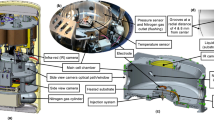Abstract
We analyze the possibilities of decreasing the errors of measuring the height of the pole of a sessile drop of melt above its equator by determining the position of the equator according to the midpoints of vertical chords of the image of the drop. The optimal distance between these chords and the edge of the image of the drop is chosen within 10–20% of the radius of the equator. The proposed method guarantees the same level of errors of evaluation of the height of the pole and the radius of the equator, which enables one to substantially increase the accuracy of evaluation of the capillary constant and the surface energy of the melt according to the geometric parameters of the sessile drop.
Similar content being viewed by others
REFERENCES
Yu. M. Ivashchenko and V. N. Eremenko, Fundamentals of Precision Measurements of the Surface Energy of Melts by the Method of Sessile Drops [in Ukrainian], Naukova Dumka, Kiev (1972).
P. V. Novitskii and I. A. Zograf, Evaluation of Measurement Errors [in Russian], Énergoatomizdat, Leningrad (1991).
E. B. Dismukes, “The effect of drop size on the accuracy of surface tension determination by the sessile-drop method,” J. Phys. Chem., 63, No. 2, 313–334 (1959).
Author information
Authors and Affiliations
Rights and permissions
About this article
Cite this article
Lychak, O.V., Nechyporuk, S.A. & Pidzharyi, V.M. Possibilities of Decreasing the Errors of Determination of the Height of the Pole of a Sessile Drop of Melt. Materials Science 36, 602–606 (2000). https://doi.org/10.1023/A:1011334726594
Issue Date:
DOI: https://doi.org/10.1023/A:1011334726594



